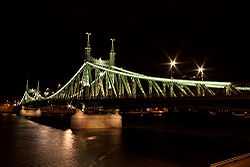Liberty Bridge (Budapest)
The Szabadság híd (in English: Liberty Bridge or Freedom Bridge) in Budapest, Hungary, connects Buda and Pest across the River Danube. It is the third southernmost public road bridge in Budapest, located at the southern end of the City Centre. It was originally named Ferenc József híd (Franz Joseph Bridge). At its two ends are:
- Gellért tér (at the foot of Gellért Hill, with the Gellért Spa and Hotel Gellért) and
- Fővám tér (with the Great Market Hall and the nearby Budapest University of Economics).
The bridge was built between 1894 and 1896 to the plans of János Feketeházy. Although radically different in structure, the bridge imitates the general outline of a chain-type bridge, which was considered an aesthetically preferable form at the time of construction. The bridge was opened in the presence of Emperor Franz Joseph; the last silver rivet on the Pest abutment was inserted into the iron structure by the Emperor himself, and the bridge was originally named after him.
It is 333.6 m in length and 20.1 m in width. The top of the four masts are decorated with large bronze statues of the Turul, a falcon-like bird, prominent in ancient Hungarian mythology.
Many trams used to cross the twin-road bridge, which was also heavily burdened with car traffic, and there is an initiative to convert it to a pedestrian-only crossing once the fourth underground metro line is completed in Budapest in the coming decade.
Gallery
See also
- List of crossings of the Danube River
External links
- DBridges - Szabadsg hd
- Photos of Budapest bridges
- Budapest Tourism Office on Szabadsg hd
- Freedom Bridge at Structurae
- Picture
- Four more photos: (1), (2), (3), (4)
- Bridges of Budapest - Liberty Bridge
| ||||||||||||||
| Wikimedia Commons has media related to Szabadság híd. |
Coordinates: 47°29′09″N 19°03′18″E / 47.48583°N 19.05500°E




